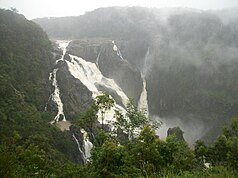Barron Gorge National Park
| Barron Gorge National Park | ||
|---|---|---|
| Barron Falls | ||
|
|
||
| Location: | Queensland , Australia | |
| Specialty: | water falls | |
| Next city: | Kuranda, Cairns | |
| Surface: | 28.25 km² | |
| Founding: | 1940 | |
| Barron Falls (January 2005) | ||
The Barron Gorge National Park (English: Barron Gorge National Park ) is a national park in the northeast of the Australian state of Queensland . It is located about 1600 km northwest of Brisbane , about 14 km northwest of Cairns and 2 km southeast of Kuranda . The park is part of the Wet Tropics of Queensland . The Kuranda Scenic Railway runs through the park and has a train station at Barron Falls . A train runs once a day in each direction to and from Cairns. The old weir from 1934 from the upper end of the falls can be seen from the viewpoint at the train station.
Terrain forms
Barron Gorge was formed where the Barron River plunges over the eastern rocky steps of the Atherton Tablelands . The Barron Falls form a 25 m high cascade to the bottom of the gorge. Two waterfalls - the Stoney Cteek Falls and the Surprise Creek Falls - are located on tributaries of the Barron River in the park. The slopes of Barron Gorge are steep, some of which are inclined at 45 °. This created dangers in the construction of the railway line. 23 people died during construction.
history
In 1885, the explorer Archibald Meston described the Barron Falls at high tide, where the waters were wild
" rush together like wild horses as they enter the straight in the dread finish of their last race (...) (where) the currents of air created by the cataract waved the branches of the trees hundreds of feet overhead (...) the rock shook like a mighty steamer tumbling with the vibrations of the screw. "( Eng . : rushing together like wild horses when they turn into the home straight of their last race (...) (where) the air turbulence caused by the cataract, the branches of the trees hundreds Meters higher (...) the rock pounded like a large steamship that swayed due to the vibrations of the screw)
In 1935, the waters of the Barron Falls were tamed at the Barron Gorge Hydroelectric Power Station, operating Queensland's first hydroelectric power station. An underground power station was cut into the rock 200 m from the lower end of the Barron Falls. The water was piped onto the turbines, which powered two 1,200 kW alternators. The substation, the workshops and the social rooms were built in the area and today form the Skyrail station.
The ownership of the park area was returned to the old owners ( Aborigines ) on December 17, 2004 . Nothing has changed for visitors under the new owners, but the Aborigines are now allowed to hold traditional religious ceremonies there.
Flora and fauna
Bird's nest ferns ( Pteridophytum nidularium ) and antler ferns ( Platycerium ) grow between light walnut trees , Duboisia , native olives ( Bursaria spinosa ) and false red sandalwood ( Adenanthera pavonina ) at the bottom of the gorge.
The park is part of the Wooroonooran Important Bird Area . This has been classified by BirdLife International because it is habitat for a number of endemic bird species in the Wet Tropics of Queensland. Buntpittas and Reinward hens can be found all over the park. The cassowary can occasionally be seen in the southern part of the national park. Nocturnal animals are relatively common, e.g. B. one finds a number of possums and fruit bats, as well as the Lumholtz tree kangaroo and the miniature sacred marten .
Web links
- Barron Gorge National Park . Department of National Parks, Recreation, Sport and Racing, Queensland
- Barron Gorge National Park . Queensland Holidays
- World Database on Protected Areas - Barron Gorge National Park (English)
Individual evidence
- ↑ CAPAD 2010 . ( MS Excel ; 170 kB) Australian Government, DSEWPaC , accessed on January 7, 2013 (English)
- ↑ CAPAD 1997 . ( MS Excel ; 93 kB) Australian Government, DSEWPaC , accessed on January 7, 2013 (English)
- ↑ a b Barron Gorge National Park . Department of National Parks, Recreation, Sport and Racing. Retrieved December 28, 2012.
- ^ Kuranda Scenic Railway - The Tour . Queensland Rail. Archived from the original on March 31, 2009. Info: The archive link was automatically inserted and not yet checked. Please check the original and archive link according to the instructions and then remove this notice. Retrieved May 8, 2009.
- ↑ a b c d e Peter Shilton: Natural areas of Queensland . Goldpress, Mount Gravatt, Queensland 2005, ISBN 0-9758275-0-2 , pp. 45-47 (accessed June 20, 2011).
- ^ Jeff Waters: National park to be handed back to traditional owners (transcript) In: AM . Australian Broadcasting Corporation. December 17, 2004. Retrieved October 23, 2009.
- ↑ Important Bird Areas factsheet - Wooroonooran . BirdLife International (2011). Downloaded from birdlife.org on December 2, 2011


